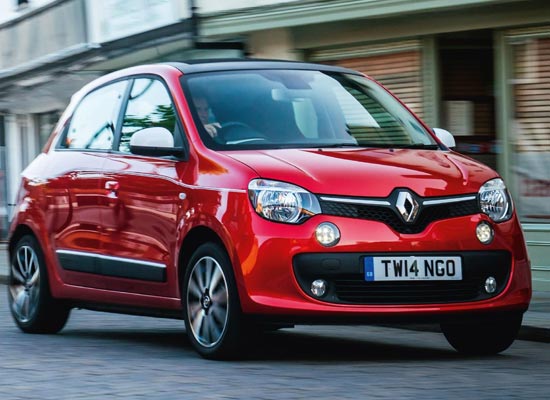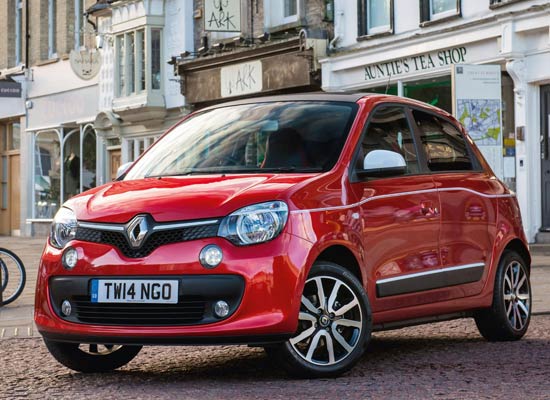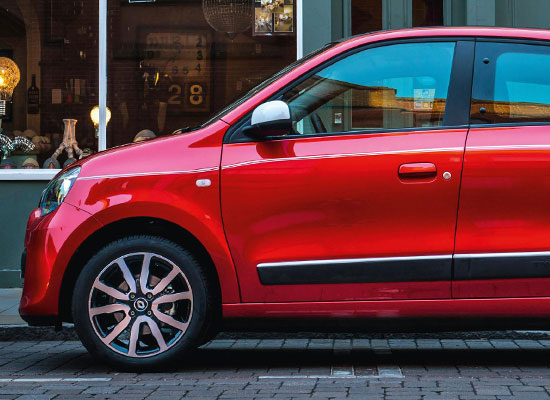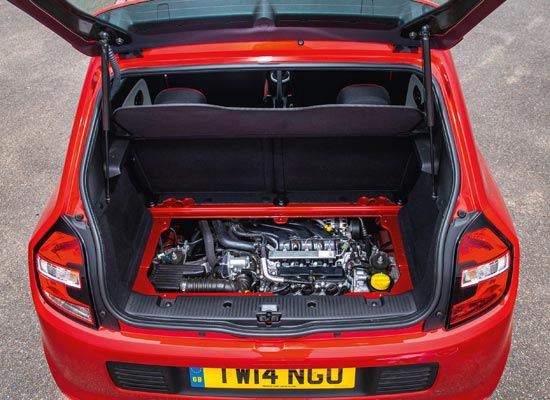For a car enthusiast, setting eyes on the new Renault Twingo for the first time..
[/vc_column][/vc_row][vc_row border=”none” bg_color=”rgba(255,255,255,0.27)” padding_top=”0px” padding_bottom=”0px” no_margin=”true”][vc_column width=”1/1″ fade_animation=”in-from-right” fade_animation_offset=”350px”]must feel like being a twitcher who finally gets to see the elusive bird he has been seeking all his life. “So here it is, at last!” the fan exclaims. “How perfect!”
[/vc_column][/vc_row][vc_row border=”none” bg_color=”#ffffff” padding_top=”25px” padding_bottom=”20px”][vc_column width=”1/1″ fade_animation=”in-from-left” fade_animation_offset=”350px”]If, in your mind’s eye, you had been drawing up a contemporary successor to those rear-engined post-war classics, Renault’s 4CV and Dante Giocasa’s Fiat 500, the new Twingo might be exactly the ideal you would come up with. The design and shape of Renault’s first rear-engined car for almost 50 years concertinas the decades with delightful elan.
It is the perfect image of the car that Fiat should have created in 2007 when they were looking to exploit the enduring sentimentality around the 500s and 600s of the middle of the last century but concocted, instead, that vulgar, cynical Panda-based pastiche, the Fiat 500, which was neither rear-engined nor built in Italy.
High-roofed and dumpy, pert, cute and self-assured, Renault’s all-new city car is as refreshingly original as the very first Twingo which appeared in 1992. That spare, utilitarian, throwaway three-door hatchback was the highest work of genius of Renault’s then head of design, Patrick Le Quement. The new five-door hatchback puts Hungarian born Csaba Wittinger in the same league.
There are good reasons to place the engine in the back of a car. Driving the rear wheels abbreviates the power-train, creates more space in the middle for humans and sharpens handling and steering at the front end. Against those benefits, tooling-up a factory to produce a small rear-engined car would probably eliminate every penny of the profit it might deliver unless the manufacturer could get into cost-sharing agreements with other manufacturers.
That’s precisely the approach that has now resulted in the new Twingo. Renault did a deal with Mercedes to share the three-cylinder 900cc and one-litre engines they jointly created. Mercedes will use the engines for the new Smart. Renault’s share goes into the new Twingo.
The “so far, so very good” story continues with the interior where contrast colours for upholstery, armrests and glove box make it look as if somebody has been studying the Zoe, Renault’s nifty electric car. Renault’s standard switchgear and secondary controls are fitted but if you start to move up through the specification options you can end up with a bill for almost £15000. The basic price for the Play SCe version we borrowed is £9995 but the price as tested – including an £850 sliding fabric sunroof – would be £11500. The four adults can sit in the high seats on the flat floor without contorting their backs or mingling their limbs (unless, of course, that should be their chosen preference) and, unlike some city cars, you don’t have to have been practising your yoga to get in and out of the back.
[/vc_column][/vc_row][vc_row border=”none” bg_color=”rgba(255,255,255,0.27)” padding_top=”15px” padding_bottom=”5px”][vc_column width=”1/2″ fade_animation=”in-from-right” fade_animation_offset=”350px”]
 [/vc_column][vc_column width=”1/2″]
[/vc_column][vc_column width=”1/2″]
 [/vc_column][/vc_row][vc_row border=”none” bg_color=”#ffffff” padding_top=”25px” padding_bottom=”20px”][vc_column width=”1/1″ fade_animation=”in-from-left” fade_animation_offset=”350px”]
[/vc_column][/vc_row][vc_row border=”none” bg_color=”#ffffff” padding_top=”25px” padding_bottom=”20px”][vc_column width=”1/1″ fade_animation=”in-from-left” fade_animation_offset=”350px”]The luggage space under the hatch, however, is barely bigger than a desk drawer and the luggage cover is connected to the hatch by a couple of flimsy cords with cheapskate hooks. They give the impression that corners might have been cut on the build quality of this car – an impression which is confirmed by the fingertip-wide gaps between some of the body panels. Those alarming gaps probably contribute to the rattling in this car as it goes along but the main culprit is the engine itself which wobbles and vibrates on its mountings when the car is standing still almost as violently as an old 2CV.
Meanwhile the 70 bhp and 91 NM of torque or pulling power in the one-litre version we borrowed is delivered in unpredictable lumps. Power can dip perplexingly when trying to pull away on hills and tends to run out in higher gears at surprisingly modest speeds.
All the expected benefits in handling and steering are supplied in abundance. The Twingo’s turning-circle is tighter than a garden tractor’s, making it as manoeuvrable for city parking as a Smart.
In point of fact, this is a car that should probably be used only in cities. Once you get beyond the 40 mph limit, you begin to long for an engine in front – preferably driving the rear wheels.
[/vc_column][/vc_row][vc_row border=”none” bg_color=”rgba(255,255,255,0.27)” padding_top=”0px” padding_bottom=”20px”][vc_column width=”1/1″ fade_animation=”in-from-right” fade_animation_offset=”350px”][/vc_column][/vc_row][vc_row border=”none” bg_color=”rgba(255,255,255,0.27)” padding_top=”300px” padding_bottom=”300px” inner_container=”true” no_margin=”true” bg_image=”72251″][vc_column width=”1/1″ fade_animation=”in-from-right” fade_animation_offset=”350px”][/vc_column][/vc_row][vc_row padding_top=”30px” padding_bottom=”32px” border=”none” bg_color=”#6b6e7e” inner_container=”true” no_margin=”true”][vc_column width=”1/1″ fade_animation=”in-from-top” fade_animation_offset=”50px” fade=”true”]
[/vc_column][/vc_row][vc_row padding_top=”30px” padding_bottom=”40px” border=”none” bg_color=”#d3000f” inner_container=”true” no_margin=”true”][vc_column width=”1/1″ fade=”true” fade_animation=”in-from-top” fade_animation_offset=”50px”]
Share the Renault Twingo Review








